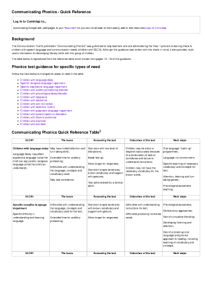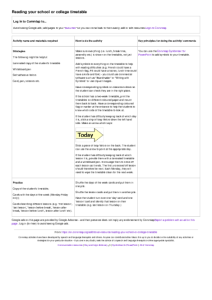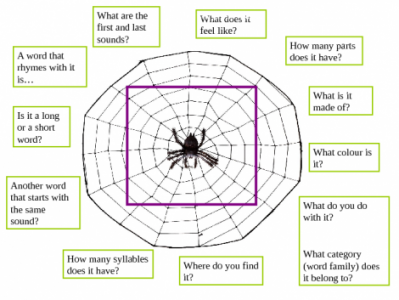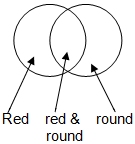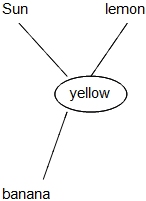Search
User login
Topic “Vocabulary/word finding”
Communicating Phonics - Quick Reference
Created 13 June 2012; updated 6 December 2024.
Communicating Phonics - Quick Reference
Background
The Communication Trust's publication "Communicating Phonics" was published to help teachers who are administering the Year 1 phonics screening check to children with speech language and communication needs (children with SLCN). Although this guidance was written with this check in mind, it also provides much useful information for developing literacy skills with this group of children.
The table below is reproduced from the reference table which comes from pages 12 - 16 of this guidance.
Reading your school or college timetable
Created 15 May 2012; updated 6 December 2024.
Reading your school or college timetable
| Activity name and materials required |
To use language to describe the characteristics and functions of objects
| Activity/strategy name and materials required | How to do the activity | Key principles for doing the activity and comments |
|---|---|---|
| What's in the bag? - Bag - A selection of objects or pictures - click below for printable object pictures: - Question prompt cards - click here to print.
| 1. Explain to your child/student that you are all going to take it in turns to put something in the bag and describe it for others to guess. 2.Model the game for the first turn. Give a description of your obejct for the others to guess. 3. Swap and let your child/student have a turn. If your child/student is finding it hard to think of things to saym you can use the questions cards to help support them. | |
| Treasure Hunt - Objects to hide around the room (optional) | ||
| Taboo! . |
Word Web Template 3
Created 23 November 2010; updated 14 December 2021.
use adjectives to describe and classify objects
| Activity/strategy name and materials required | How to do the activity | Key principles for doing the activity and comments |
|---|---|---|
| Classify the object 1
| 1. Decide on a common category e.g. "things which are round" or "things which are red". 2. Help the child to sort the items into 2 groups according to whether they fit the category or not (i.e. a 'red' group and a 'not red' group). | |
| Classify the object 2 A selection of common objects (you could use pictures instead) 2 sorting rings (draw two overlapping circles on a large sheet of paper if these are not available)
Category labels (optional) | 1. Decide on two common categories e.g. "things which are round" and "things which are red". 2. Place the sorting rings on the table so that they overlap. 3. Explain that one ring is for items that have one feature (e.g. "round"). Explain that the other ring is for items that have the other feature (e.g. "red"). Explain that where the rings overlap, is where things that have both features go (see diagram on the left). Items which do not fit either category are left outside the rings. 4. Add labels if you are using them. 5. Help the child to sort the items into groups according to which category they fit. | To make this activity more difficult, you could sort according to three categories. |
| Spider chart
| Example of a spider chart:
| |
| What's in the bag?
| ||
| Nicknames No materials required | Works well as a group activity - could be used as an ice-breaker. | |
| I spy adjectives No materials required. | ||
| Books
|
Activities to develop categorising items by where you find them/location
| Activity/strategy name and materials required | How to do the activity | Key principles for doing the activity and comments |
|---|---|---|
| Soring by location activity | 1. Print and cut out the resource. 2. Choose how many categories your child is going to sort - it may be best to start with 2 or 3, before making it harder by adding extra categories. 3. Shuffle the items to be sorted. Each take a turn at choosing an item, naming it and placing in the correct location. 4. If your child is finding challenging to name items, use some of the strategies in the word finding information sheet linked above. | |
| Make a collage - Paper - Glue - A selection of pictures from your chosen category. |
Developing the skill of sorting items into categories
| Activity/strategy name and materials required | How to do the activity | Key principles for doing the activity and comments |
|---|---|---|
| Sorting items by category - Printable category picture cards: Or use a seletion of your own real objects or pictures. | 1. Print and cut out the large category cards and the small picture cards. 2. Start by sorting items from teo different categories. 3. Place the picture cards from the categories face down. Explain to your child you are going to sort the items into groups. 4. Each take a turn at choosing a picture card, naming them item and placing it in the on the appropriate category card. 5. If your child is able to sort items into two catgories, next attemp items from three different categories. | If your child is finding this task challenging, you can help by searching for an item together.
If your child is able to do this activity, when they select a card, you could ask them to think of another item that belongs to that subcategory but is not in the picture cards. You could also move on to the activities that involve sorting items into subcategories - click here. |
Categories - to recognise the odd one out
| Activity/strategy name and materials required | How to do the activity | Key principles for doing the activity and comments |
|---|---|---|
| What's in the bag - Draw string bag - Sets of objects, for example: Groups of pens, cars, Lego bricks. - You could also use objects which differ markedly in texture, for example six normal pieces of paper and a piece of sandpaper. If you do not have obejcts available you could print out and use a selection of category cards below: | 1. Put a group of objects/pictures into a bag and add one clearly different object/picutre. 2. Take turns taking things out of the bag and saying/signing what they are. 3. Comment on the item that is different, for example "look... this is the odd one out" or "this is different" (look surprised, puzzled, make an exclamation). | |
| Odd one out pictures |
Name 2d shapes e.g. square
| Activity/strategy name and materials required | How to do the activity | Key principles for doing the activity and comments |
|---|---|---|
| Shape pairs A set of cards with shapes you are working on - say four with squares on, four with triangles on, four with rectangles on and four with circles on. |
| Make sure you have a go as well as the children. Take your go in the same way as they do, saying the name of the shape as you turn it over. If the child struggles to say the name of the shape, say it for them. Having lots of goes rather than labouring over one go is likely to be more satisfying for the children. Variations Shapes and object pictures Half the cards have the shape picture on, the other half have pictures of objects that are that shape (viewed from an angle that looks like that shape) - for example: book, iPad, ball, clock, door, coin, cheese triangle, end of Toblerone box, road warning sign. To make pairs, you now have to match a shape to an object picture. Call out the shapes for the objects and shape pictures as before. Object pictures |
| Models with 2D shapes Printed cards with pictures of the shapes and their names. Selection of 2D shapes. | Start with a small number of shapes - e.g. squares and triangles. |
Understand and use larger
| Activity/strategy name and materials required | How to do the activity | Key principles for doing the activity and comments |
|---|---|---|
| Drawings Drawings of houses and stick man families | Draw pictures of houses with windows and say 'Look...this house has 10 windows...it is larger/bigger. Draw stick man families and say 'Look...5 children here - this family is larger.' | Avoid working on larger with a contrasting word (such as smaller) until the child is confident with 'larger'. Contrasting concepts taught together can be confusing for the child. Once the child is confident with both larger and smaller (from work in separate activities on separate occasions) you can incorporate both concepts in this activity. |
| Washing up Dirty dishes Sink/bowl Water/detergent | Avoid working on larger with a contrasting word (such as smaller) until the child is confident with 'larger'. Contrasting concepts taught together can be confusing for the child. Once the child is confident with both larger and smaller (from work in separate activities on separate occasions) you can incorporate both concepts in this activity. | |
| Objects Play dough, dried beans | Avoid working on larger with a contrasting word (such as smaller) until the child is confident with 'larger'. Contrasting concepts taught together can be confusing for the child. Once the child is confident with both larger and smaller (from work in separate activities on separate occasions) you can incorporate both concepts in this activity. |
Understand and use prepositions
| Activity/strategy name and materials required | How to do the activity | Key principles for doing the activity and comments |
|---|---|---|
| Physical Activities Materials to use can include: playground equipment, furniture, boxes, hoops, bean bags etc | Show the child how they can be 'on', 'in', 'under' etc these objects. When they are doing an action, say where they are, for example, 'you're under the slide', 'you're on the swing', 'you're under the blanket'. You can extend this by giving the child instructions containing the prepositions you are working on. | |
| Hide and seek with toy animals Table, chair, box, teddy, doll | While the doll is not looking, get the child to hide the teddy somewhere by giving them an instruction for example 'put him under the chair'. (Work on no more than two or three prepositions at a time). The doll comes back and asks questions such as 'Is he on the chair', 'Is he under the table' Give the child an opportunity to say where to hide the teddy. Give them a forced alternative, for example 'shall we put him in or under the box' using a sign for each preposition or physically showing the two positions of the teddy along with each word. | |
| Lotto game Lotto cards containing pictures of things in different positions, for example teddy on the table, teddy under the table etc. | ||
| Tea party Dolls, tea-set | ||
| Obstacle course for example: hoops, table, chair | ||
| Giving a puppet instructions puppet, objects such as spoon, cup, brush etc. | ||
| Tidy up | ||
| Nursery Rhymes |
Activities to develop understanding and use of position words (prepositions) in, on and under
| Activity/strategy name and materials required | How to do the activity | Key principles for doing the activity and comments |
|---|---|---|
| Physical activities Preposition symbols Playground equipment Furniture, boxes, hoops etc. If you don't have any, you can get preposition symbols - such as "on", "in", "under", "over" - using the Commtap Symboliser. | 1. Introduce one preposition concept at a time. 2. Get your child to do an action by saying "Stand on the bench" and then show them what you mean by standing on the bench, showing them the 'on' symbol and then encouraging them to copy you. 3. What other things can they stand on? 4. Once they are familiar with the first preposition, then introduce the next one. 5. Remember to show your child what to do when you introduce a new concept, as well as supporting it using visual clues. | Remember to support these activities with additional visual clues including signing and the symbols. In addition to working on the prepositions during particular activities, utilise every day opportunities to comment on what your child is doing. For example, by saying "You are on the slide. If you don't know the sign for a preposition, ask your Speech and Language Therapist. It may take one or more sessions before the child has understood the first preposition and before you can move on to another one. |
| Obstacle Course Various objects such as table, chair, bench, hoop, etc. Masking tape Preposition symbols You can get preposition symbols - such as "on", "in", "under" - using the Commtap Symboliser. | It may be easier to do this activity when your child is familiar with the prepositions or if you have another adult to help your child complete the obstacle course. Have fun!!! It can be a race with other children. | |
| Obstacle Course with toy animals/puppets Toy animals/puppets Real or miniature furniture Masking tape Preposition symbols You can get preposition symbols - such as "on", "in", "under" - using the Commtap Symboliser. | ||
| Hide and seek with toy animals Table, chair, box, teddy, doll. Preposition symbols. You can get preposition symbols - such as "on", "in", "under" - using the Commtap Symboliser. |
pupils use words left and right on objects in front of them
| Activity/strategy name and materials required | How to do the activity | Key principles for doing the activity and comments |
|---|---|---|
| Put it there One large object such as a toy bus, house etc. Several smaller objects e.g. toy animals Prompt cards saying "left" and "right" | 1. Put the large object in the centre of the table in front of the child. 2. Ask the child to identify the left side and the right side. Help if necessary. 3. Put the "left" and "right" prompt cards to the left and right of the object. 4. Give the child instructions such as "put the lion to the right of the bus" 5. Swap roles so that the child has a chance to give the instructions. 6. When the child is fairly proficient at carrying out the activity with the prompt cards, try the activity with no prompts. | The child should be able to understand and refer to left and right when talking about their own body first (see "understand and use words left and right on own body"). You should sit next to the child so their left/right is the same as your left/right. Note: if you are sitting opposite the child and want them to refer to your left and right this is a more difficult task: this equates to working at Level 3 (8 to 9 year old typical development). |
| "Draw it" barrier activity Paper Pens Cards with pictures of two items drawn next to each other, e.g. car and cat, tree and house | ||
| Matching pairs Matching pairs cards. Visual prompt for left, right, up and down like this: ↑ up ←left right→ down ↓ | Sit next to the child so that your left is the same as their left. Note: if you are sitting opposite the child and want them to refer to your left and right this is a more difficult task: this equates to working at Level 3 (8 to 9 year old typical development). Use an appropriate number of pairs for the age and ability of the child. If the child struggles with giving instructions using up/down, put the cards in one long horizontal line and work only on "left" and "right". Vary your starting point so the child has the opportunity to use all the direction words. You can use the words further and nearer instead of up and down, if it is more appropriate, but you must be consistent in which word you choose. |
Support Commtap to keep it online
Thank you for visiting Commtap.
Please read this message as it is extremely important.
- Visitor donations mean we can continue to host over 1,000 free activities to support speech, language, and communication development.
- Visitor donations mean we can continue to provide free resources to address a wide range of communication needs, including limited speech or language, interaction challenges, and needs associated with conditions such as developmental language disorder, autism, and cerebral palsy.
- Visitor donations mean we can continue to provide resources to support the work of speech and language therapists, teachers, teaching assistants, parents, and carers.
- Visitor donations mean we can continue to provide the free key word sign dictionary (bks.org.uk) which has over 2,000 Makaton and Signalong signs.
We know that not everyone is able to afford to pay to access these resources, however, if you can, please make a donation to keep the site going.
Thank you
Google ads on this page are provided by Google Adsense - and their presence does not imply any endorsement by Commtap. Report a problem with an ad on this page. Log in (for free) to avoid seeing Google ads.
